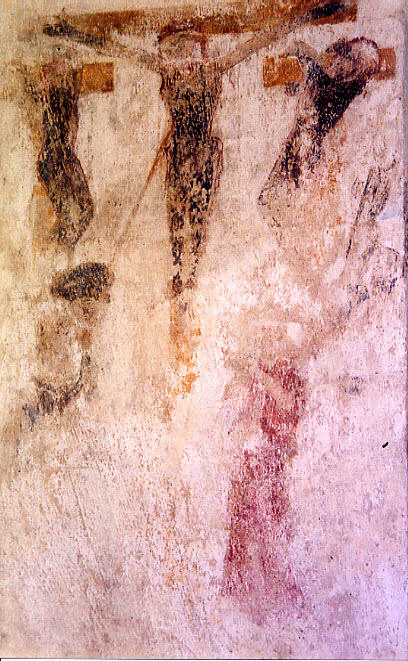Barnby, Suffolk (†St Edmundsbury & Ipswich) C.15
Crucifixion

The finest of the paintings at Barnby and almost certainly the latest in date. This is a very rare appearance of the Two Thieves and the only one I have seen in the English church to show both of them¹ (unlike the earlier example at Wisborough Green which shows only the Penitent Thief, albeit together with a very interesting configuration of the Cross-beam).
Here the painter has managed to suggest something other than a straightforward row of crucified figures, all facing squarely to the front. Something of this shows in the articulation of the figure at the left of the photograph, but it is most marked in the way the other Thief and his cross are disposed at the right, where the painter has clearly tried to angle the cross and the figure so that the Thief appears to be in a slightly different lateral plane from Christ in the centre, farther back into the implied distance.
In the centre is the crucified Christ, nailed to the Cross and with legs straight – unlike the two thieves, who are fastened to their crosses with arms hooked over the transverse beams and pinioned behind. Their legs are bent, and the head of the Thief at the right visibly slumped forward. At the lower left are the faint remains of Longinus, possibly wearing some kind of dark-coloured headgear, and with his lance piercing Christ’s side. An area of dark pink pigment to the right was probably St John and some other faint pigmentation at the far right might be another figure carrying a ladder.
All in all, I think this represents a late development in English medieval church painting. Some aspects of it suggest comparison not with other English provincial Crucifixions but rather with some treatments of the subject – not after all much later – by the German painter Lucas Cranach²
The other paintings at Barnby-the Annunciation and the Seven Works of Mercy have been on the site for some time.
¹ No longer true. Amberley in Sussex also has both thieves – the Impenitent one unfortunately very damaged and faint. Its date is problematic however.
² Lucas Cranach the Elder, 1472-1553. (But his style and that of his son Lucas Cranach the Younger are well-nigh indistinguishable).